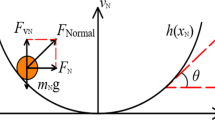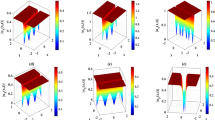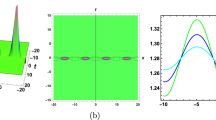Abstract
This paper is the second one devoted to studying the dynamical behavior of a rotating uniform string with one fixed top point. Two-dimensional shapes of relative equilibrium for a string were analyzed in our paper [3] both analytically and numerically and found to be instable. This fact disagrees with the experimental appearance of this so-called helicoseir problem because one can easily demonstrate that its stable motion is possible. In this paper, spatial nonlinear equations of motion are derived and shown that a 2D equilibrium equation is one of their partial cases. The equations are, however, very complicated that is why we decided at first to analyze the motion numerically by a finite element approach called the absolute nodal coordinate formulation (ANCF). We developed a new 12-dof element of a thin string based on the Euler-Bernoulli theory. The simulation shows that the undamped spatial motion of the helicoseir is stable and looks like self-excited oscillations near the flat instable configurations that were obtained previously. This stability is destroyed when external damping is added to the system. Some examples of bifurcation instability fore spatial motion are presented; they satisfy the bifurcation diagram obtained in the previous work. Unfortunately, numerical simulation cannot give answers to some interesting questions, e.g. dependence of parameters of the self-excited oscillations on the angular velocity of rotation. Thus, further analytical research of this problem is desirable.
Similar content being viewed by others
References
Berzeri, M. and Shabana, A.A., ‘Development of Simple Models for the Elastic Forces in the Absolute Nodal Co-ordinate Formulation’, in Journal of Sound and Vibration 235(4), 2000, 539–565.
Dahlquist G., Björck Å. and Anderson N., Numerical methods, Prentice-Hall, Englewood Cliffs, New Jersey, 1974.
Dmitrochenko O., Yoo W.-S. and Pogorelov D., ‘Helicoseir as shape of a rotating chain (I): 2D theory and simulation using ANCF’, submitted to Multibody System Dynamics.
Gear C.W., Gupta G.K. and Leimkuhler B., ‘Automatic integration of Euler-Lagrange equations with constraints’, in Journal of Computational and Applied Mathematics 12(13), 1985, 77–90.
Merkin D.R., Introduction to mechanics of elastic thread, Nauka, GRFML, Moscow, 1980 (in Russian).
Pogorelov, D., ‘Some developments in computational techniques in modeling advanced mechanical systems’, in Proceedings of IUTAM Symposium on Interaction between Dynamics and Control in Advanced Mechanical Systems, D.H. van Campen (Ed.), Kluwer Academic Publishers, Dordrecht, 1997, 313–320.
Pogorelov, D., ‘Differential-algebraic equations in multibody system modeling’, in Numerical Algorithms 19, Baltzer Science Publishers, 1998, 183–194.
Schwertassek, R., ‘Flexible Bodies in Multibody Systems’, in Computational Methods in Mechanical Systems 161, Springer Verlag, 1997, 329–363.
Shabana, A.A., An absolute nodal coordinate formulation for the large rotation and large deformation analysis of flexible bodies // Techn. Rep. No. MBS96-1-UIC, Dept. of Mech. Eng., Univ. of Illinois at Chicago, March 1996.
Shabana, A.A., ‘Flexible Multibody Dynamics: Review of Past and Recent Developments’, in Multibody System Dynamics 1, 1997, 189–222.
Shabana, A.A. and Yakoub, R.Y., ‘Three Dimensional Absolute Nodal Coordinate Formulation for Beam Elements: Theory’, in Journal of Mechanical Design 123, 2001, 606–621.
Silverman, M.P., Strange, Wayne and Lipscombe, T.C., ‘String theory: Equilibrium configurations of a helicoseir’, in European Journal of Physics 19, 1998, 379–387.
Takahashi, Y. and Shimizu, N., ‘Study on Elastic Forces of the Absolute Nodal Coordinate Formulation for Deformable Beams’, in ASME Proceedings of Design Engineering Technical Conference, VIB-8203, Las Vegas, 1999.
Wriggers P., Nichtlineare Finite-Element-Methoden, Springer, Berlin, 2001.
Yoo, W.-S., Lee, J.-H., Park, S.-J., Sohn, J.-H., Dmitrochenko, O.N. and Pogorelov, D.Yu., ‘Large Oscillations of a Thin Cantilever Beam: Physical Experiments and Simulation using Absolute Nodal Coordinate Formulation’, in Journal of Nonlinear Dynamics 34(1), 2003, 3–29.
Zienkiewicz, O.C. and Taylor, R.L., The Finite Element Method, 4th Edition, Volume 2: Solid and Fluid Mechanics, McGraw-Hill Book Company, 1991.
Zwillinger D., Standard mathematical tables and formulae, 31st edition, Chapman & Hall/CRC, 2003.
Author information
Authors and Affiliations
Corresponding author
Rights and permissions
About this article
Cite this article
Dmitrochenko, O., Yoo, WS. & Pogorelov, D. Helicoseir as Shape of a Rotating String (II): 3D Theory and Simulation Using ANCF. Multibody Syst Dyn 15, 181–200 (2006). https://doi.org/10.1007/s11044-005-9004-0
Received:
Accepted:
Published:
Issue Date:
DOI: https://doi.org/10.1007/s11044-005-9004-0




